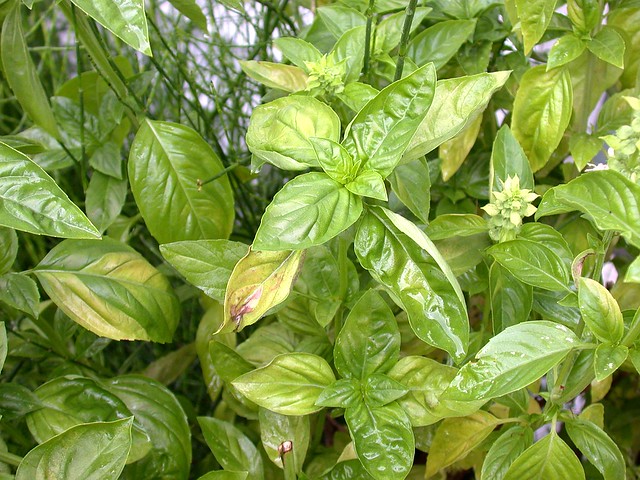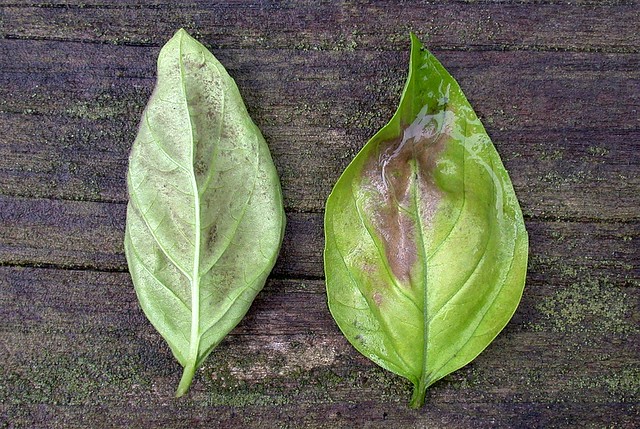
Yellowing leaves: an early sign of Basil Downy Mildew
I just harvested what will probably be my last batch of basil (Ocimum basilicum), for what will probably be my last batch of pesto this year. This is depressing for several reasons. First, I love basil and I love pesto, and I always find the end of the basil season a bit depressing. Second, my basil usually lasts much longer, only petering out in October once nights start turning consistently chilly. But most of all, I'm depressed because I discovered that my basil has Basil Downy Mildew, a new disease that I've never encountered before, and that promises to be a major problem for basil growers--and lovers--in the next few years.

Leaf discoloration from Basil Downy Mildew
One thing I love about basil is how fast it grows, and how productive even two or three plants can be. I grow my basil in a container on my back deck, where it gets the heat and sun it loves all day long. I never start it from seed, always buying plants from a local garden center or farmer's market, and this year started like any other. The first sign that something was wrong came just a couple of weeks ago, when I noticed yellowing older leaves on my basil. But it was still vigorous and growing strongly, was yielding well, and I thought maybe I had stressed it by over- or under-watering it. Consistent watering is not my strong suit! But the yellowing progressed, the older leaves developed brown lesions and started dropping off, and younger and younger leaves were affected. When I harvested the basil I noticed a dark fuzzy discoloration on the leaf undersides, which I assumed was some kind of mildew. I still wasn't terribly concerned; I've had mildew on various garden plants, and this seems to be an especially bad year for powdery mildew on several plants that are prone to mildew anyway: peonies, columbine, and Verbena bonariensis. I've never seen mildew on basil before, but I chalked it up to the summer being a bit cooler than usual, because basil certainly loves heat.

Leaves infected with Basil Downy Mildew, bottom (left) and top (right)
But the disease progressed rapidly so I did some Googling and that's when I started to get a bit alarmed. I sent photos to Margaret McGrath, a plant disease researcher at Cornell University, who confirmed that my plants had Basil Downy Mildew (BDM). BDM is a new disease, reported in Europe in 2001 and found in the United States for the first time in Florida in 2007 but already reported from all over the country, even Hawaii. The disease spreads quickly and easily, progresses rapidly, and can wipe out a grower's entire crop of basil in a matter of weeks. Even in its early stages the plant's foliage is disfigured and ruined for commercial use. I'm lucky this is the first time I've encountered it, but this isn't likely to be the last. No basil cultivars are (yet) known to be resistant, so I suppose that gives the plant breeders one more thing to keep them busy!

Underside of leaf infected with Basil Downy Mildew
Basil downy mildew can be controlled with fungicides, but I don't use pesticides of any kind in my garden so for now I'm at a bit of a loss and don't have any tips for control. The best advice is probably to monitor plants closely and immediately remove and destroy any that show even a hint of disease. The good news is that the mildew isn't toxic to humans, although it can and will kill your basil. More good news is that the disease probably (probably) won't survive cold winters; but it can spread by infected seeds so if you have BDM-free plants it might be wise to save your own seeds and grow your own!
Please share this post to help get the word out about this destructive new disease! Dr. McGrath and her colleagues are gathering reports of Basil Downy Mildew so if you have it, you can report it here: Basil Downy Mildew Monitoring Program (this link also has information on submitting samples). Has anybody else in the Washington, DC region encountered this disease?
For more info:
Expect and prepare for downy mildew in basil (Margaret Tuttle McGrath, Cornell University)
Downy mildew on basil (photos, Cornell University)
Basil Downy Mildew and the Ornamental Greenhouse (A.R. Chase, GPN)
Fungus threatens basil plants for this year and beyond (Adrian Higgins, Washington Post)
Downy mildew on basil (Nancy F. Gregory, University of Delaware)
Basil downy mildew (University of Maryland Extension)
2014 Basil Downy Mildew Outbreak Our Worst One Yet (Debbie Roos, NC Cooperative Extension)

Now I know what is wrong with my basil. I kept looking at it and pulling off bad leaves and thinking it was me overwatering because we have had a wet year (Baltimore area). That explains it but I am not happy. It hasn't affected my other basils, cardinal and African blue though.
ReplyDeleteAll the sources I've seen suggest that sweet or italian-type basils are the most susceptible.
DeleteI've read about this and been prepared to see it attack my plants, I'm lucky that it hasn't. I do love my basil and I'm just preparing to start making and freezing pesto, this is a game changer for those affected, I am sorry.
ReplyDeleteCommercial sources seem to be spreading this mildew far and wide. If you grow your own basil and it's mildew-free, allow it to go to seed. This is probably your best bet for avoiding it.
DeleteI'll have to look at the underside of the leaves to see if that is the problem with my basil. It's a huge culinary loss for me to lose all my plants and that seems to be what's happening. Thanks for the info!
ReplyDeleteThis disease is VERY widespread although not many people realize it yet.
DeleteYep, I've been suffering with this all summer. Put in one round of basil, it all failed. I had grown it from seed myself and I wasn't able to ID the problem, but I knew it would be best to not plant basil in that same area so I moved to a different side of the yard and put the new plants, bought organic at the Takoma Park Farmer's Market -- into a big container. Again we are seeing it on those plants. It is breaking my husband's heart -- he loves to cook Italian dishes and basil is the greatest pleasure of a home garden. Thanks for posting. I'll let McGrath know. Like you, I'm all organic, especially since basil is loved by the bees. Don't want to do anything or use anything that would hurt those important pollinators. I'll be searching for safe solutions. So sad to lose my favorite crop.
ReplyDeleteThe disease is very widespread and just about impossible to control. It's also spread by contaminated seeds. The best thing organic gardeners can do is save their own seed if their plants are mildew-free.
DeleteMy Thai basil has it. I was wondering what was wrong with it. I acquired this plant as a seedling from my local hardware store.
ReplyDeleteInteresting, I haven't heard of Thai basil being susceptible, but probably all basils are to some extent.
DeleteI had something much like this happen to my basil crop a month ago in Oella, MD. We pruned the plants rather severely, and what grew back was healthy and tasty.
ReplyDeleteI'm surprised the plants grew back healthy. Glad to hear some good news from somebody!
DeleteWe're sharing this with our customer base and many of them use their rain barrels to grow basil and other plants for home cooking.
ReplyDeleteThank you! I've grown my own basil for years, because it's so easy and so productive. This is going to be quite a blow to basil lovers everywhere.
DeleteI am successfully managing downy mildew in basil this summer at my home in NY by growing basil in pots that I bring in at night and rainy days, which is when humidity is above 85% and thus conditions are favorable for the pathogen to infect. Basil I left outside for comparison became severely affected.
ReplyDeleteThank you for sharing this! Unfortunately this will be difficult if not impossible for many home growers.
DeleteJust diagnosed my basil today, have another pot on porch that does not (yet) seem to be infected. The infected basil is in a pot with sage & it seems to have some problems with the spotting, but no brown mold under leaves. Does it spread to sage? Can the other plants in the planter survive if I pull the basil out? Thanks for any info sharing!
ReplyDeleteWelcome to 2015. I didn't know what was wrong with ALL of my basil and searched google images for basil diseases. The picture from your website matched my basil plants, except mine are worse! I am also in DC. Three sweet basil and a Thai basil appear beyond hope, but I'll give it a little time and hope for a break in rain. Rather heart breaking. Thanks for posting.
ReplyDelete